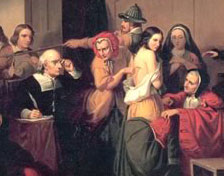talking history | syllabi | students | teachers | puzzle | about us
Salem Witch Trials Documentary Archive and Transcription Project
http://etext.virginia. edu/salem/witchcraft/
Created and maintained by Benjamin Ray, University of Virginia.
Reviewed Dec. 7, 2002—Jan. 17, 2003.
A boon to all students and scholars of early American history, the Salem Witch Trials Web site is far superior to any other resource available on the Internet for this endlessly fascinating topic. Benjamin Ray originally created the site for use in teaching, later expanding it significantly with substantial funding from NEH (National Endowment for the Humanities).

“Examination of a Witch”
Thompkins H. Matteson, 1853.
Most notably, the site contains in keyword-searchable format the entire contents of Paul Boyer and Stephen Nissenbaum’s three-volume edition of The Salem Witchcraft Papers (1977), which was based on transcriptions prepared by the Works Progress Administration (WPA) in the 1930s, and keyword-searchable texts of several important accounts reprinted in George Lincoln Burr’s Narratives of the Witchcraft Cases (1914). The site also contains images of most of the original legal documents and reproduces significant contemporary critiques of the trials. Also useful, if somewhat difficult to manipulate efficiently, are maps of Salem Village and Andover, showing the residences of accusers, accused, and witnesses. Additional items available on the site include excerpts from later fiction and poetry relevant to the trials, nineteenth- and twentieth-century artists' conceptions of the events of 1692, brief biographies of some of the accusers and accused, an interactive map of the village illustrating the accusations in March 1692, and information on a planned new edition of the legal records, with an ongoing list of corrections to the extant transcripts.
I used the site extensively while writing my recent book, In the Devil’s Snare: The Salem Witchcraft Crisis of 1692 (2002), to check my own notes on the Boyer-Nissenbaum edition against the original documents, for it has long been known that the WPA transcripts contain many errors and omissions. Most of those mistakes are small, but some are crucial, so I found that having the originals readily available—and to be able to see them in different magnifications if necessary—was of tremendous assistance.
It is easy to use either the searchable transcriptions or the originals online, especially if in the latter case the historian already knows what archive holds the documents (understandably, the images of those documents are grouped by archive and sometimes divided by collection). Yet navigating the site internally to compare the published transcription to the image of the same document is time-consuming and difficult. There is no way to move directly from one to the other—they are under different headings on the site—nor does the transcription indicate the location of the original. Thus, if one starts from the printed version, one must go back to the home page and then into the archival section before searching separate indices to find the required image. Even the best case involves four steps to access the document; the worst could take eight or more.
Nevertheless, the many benefits of this site far outweigh the failings of its internal navigation system. Ben Ray and NEH have done historians a great service by making these materials so readily accessible to all.
Mary Beth Norton
Cornell University
Ithaca, New York
